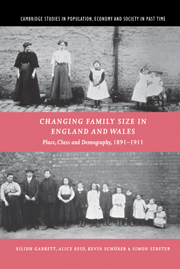Book contents
- Frontmatter
- Contents
- List of figures
- List of tables
- Preface and acknowledgements
- 1 Introduction
- 2 Locations for study
- 3 Studying locations
- 4 Infant and child mortality from the 1911 census
- 5 Fertility and fertility behaviour 1891–1911
- 6 The national picture
- 7 Class, place and demography: the mosaic of demographic change in England and Wales from Waterloo to the Great War
- Appendices
- References
- Index
- Cambridge Studies in Population, Economy and Society in Past Time
5 - Fertility and fertility behaviour 1891–1911
Published online by Cambridge University Press: 05 January 2010
- Frontmatter
- Contents
- List of figures
- List of tables
- Preface and acknowledgements
- 1 Introduction
- 2 Locations for study
- 3 Studying locations
- 4 Infant and child mortality from the 1911 census
- 5 Fertility and fertility behaviour 1891–1911
- 6 The national picture
- 7 Class, place and demography: the mosaic of demographic change in England and Wales from Waterloo to the Great War
- Appendices
- References
- Index
- Cambridge Studies in Population, Economy and Society in Past Time
Summary
Introduction
A student of statistics must have noticed that the birth rate had varied in accordance with the rate of interest for your money. Grandfather ‘Superior Dosset’ Forsyte in the early-nineteenth century had been getting ten per cent for his, hence ten children. Those ten children, leaving out the four who had not married, and Juley, whose husband Septimus Small had, of course, died almost at once, had averaged from four to five per cent of theirs, and produced accordingly. The twenty-one whom they produced were now getting barely three percent in the Consols to which their fathers had mostly tied the Settlements they made to avoid death duties, and the six of them who had been reproduced had seventeen children, or just the proper two and five-sixth per stem.
There were other reasons, too, for this mild reproduction. A distrust of their earning powers, natural where a sufficiency is guaranteed together with the knowledge that their fathers did not die, kept them cautious. If one had children and not much income, the standard of taste and comfort must of necessity go down; what was enough for two was not enough for four, and so on – it would be better to wait and see what Father did. Besides, it was nice to take holidays unhampered.
- Type
- Chapter
- Information
- Changing Family Size in England and WalesPlace, Class and Demography, 1891–1911, pp. 210 - 336Publisher: Cambridge University PressPrint publication year: 2001



